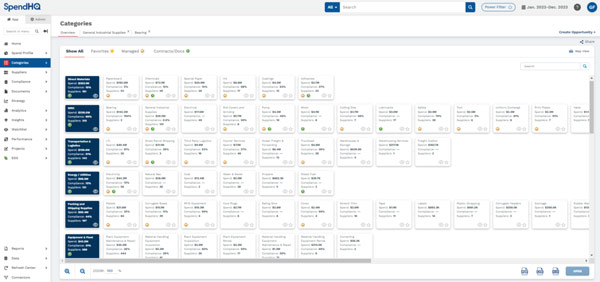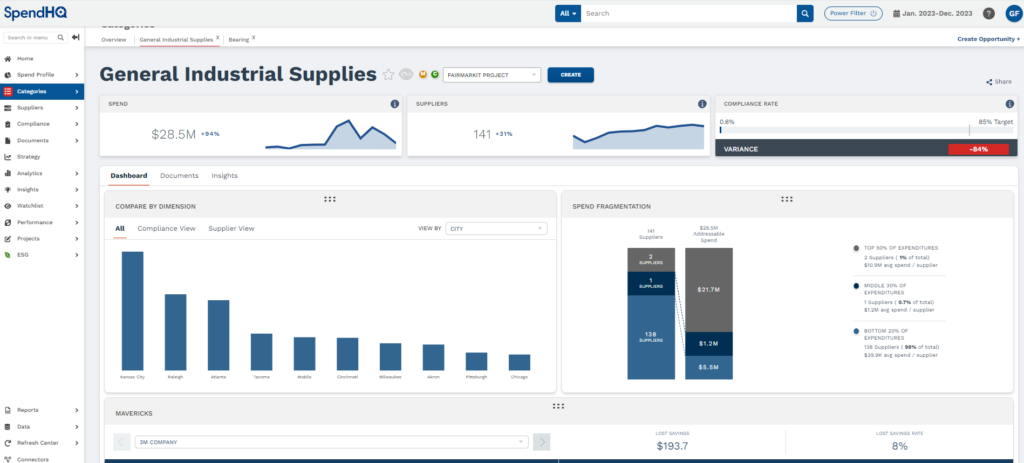Creating a Category Management Strategy Everyone Can Buy Into
The beginning of the year means it’s time to set your category management strategy and forecast the results you expect to deliver that align with overall business goals. But getting key stakeholders bought into your procurement strategies is easier said than done. 34% of CPOs interviewed in Ardent Partners’ CPO Rising research said that collaboration troubles were one of the leading hurdles on their path to impact.
So to help you make 2024 the year of category excellence, here are three steps you can take to build a category strategy the entire business can get on board with.
Make category management easy to see
Category management isn’t always easy to see in action because enterprise-level spend data is so fragmented. Even Procurement struggles to access the insights it needs to drive improvement projects across the organization and measure their impact.
These problems leave the rest of the organization asking “What value does Procurement bring to the table?” That’s not the kind of question you want to hear from cross-departmental colleagues who are integral to your category management strategy.
To fix this perspective, start by making your fragmented, hard to find spend data easy to see! The best way to do that is with accurate, comprehensive, and quick spend categorization in Spend Intelligence. With it, you can unlock accurately organized visibility into nearly 100% of your organization’s spend, as shown below.
The best part is that categorization like what the image below shows typically only takes a matter of weeks thanks to our AI and expert-driven implementation approach!
Read More: See Why the Right Spend Taxonomy Really Does Matter to Procurement

This will make the most relevant data to each category accessible in its own context rather than in a sea of generic numbers and reporting data. With this context, the stakeholders and business unit owners tied to each category will see your results and the specifics of how they affect the pieces of their work, including:
- The current state of category spend
- Savings, trends, and changes over time
- Individual supplier spend
- Payment terms
- Supplier risk ratings
- Compliance and maverick spend
- Savings leakages
- Contract impact

When the information that matters to stakeholders at all levels is accessible, you can use the current state of each category to:
- Highlight concerning trends
- Support your forecasts
- Collaborate on strategy
- Set effective plans of attack
Broader access to digestible category data means you don’t have to persuade anyone to jump on board with your category management strategy. The data will do the convincing for you.
Measure what matters, all of it
The best category management strategies tell the story of where you are now, where you want to go, and how you’re going to get there. So far, we’ve filled in the first two blanks in our strategy blueprint. Now it’s time to fill in the final one.
All leaders who succeed consistently say that year-end success comes from daily practices. The right processes will look different for each category and organization, but a core theme of process excellence is measurability. For Procurement, that means the best category management strategies have a single source of truth at their core.
A single source of truth is the place where all data, communication, and oversight into Procurement’s projects and results lives and flows. It’s also known as procurement orchestration. You can think of our solution Procurement Performance Management (PPM), which originated the concept, like a CRM for Procurement.
PPM facilitates alignment and collaboration across the business. With it, teams can suggest opportunities; work together on initiatives; update projects; and submit, track, and report on results.
In short, PPM allows Procurement to move from a manual, reactive function to a process-driven operation that creates results as a matter of being. For example, doesn’t only allow stakeholders to track project statuses. It extends stakeholder visibility by letting users tag projects in their procurement pipelines by category and subcategory, making it easier to achieve results and mitigate risk to category-specific goals.
The solution also creates a repository where relevant stakeholders can access and evaluate all data related to those operations, and it doesn’t stop at savings. It lets users create custom units of measurement (UOMs), such as scope-3 emissions or other niche metrics, and set them as the measurement of value for a category, subcategory, or project. As a result, Procurement’s reports transform from a mess of questions into authoritative statements on the function’s impact. Together, all of this leads to
- Greater outcomes, both quantitative and qualitative
- More organic partnerships
- Expanded influence
Don’t set category management strategy in a vacuum
When you combine visibility and execution, you’ll find impactable opportunities left and right. At this point, it can be tempting to run ahead of your colleagues.
However, you should be careful not to leave them behind, because they will always be your most important assets. Without buy-in from the individuals who create category spend, Procurement is basically doing busy work with little context around what’s effective and what’s counterproductive.
So how do you involve non-procurement stakeholders in procurement strategy? Starting today, involve them in your category management decisions:
- Give stakeholders ownership in category management strategies
- Set SOPs that mandate regular collaboration between category managers and business unit leaders
- Ask stakeholders for insights on procurement projects
- Involve procurement stakeholders in the early stages of requirements gathering
- Explain your decisions and back them up with numbers
- Share the credit throughout the year
One of Procurement’s lasting frustrations is coming into a contract negotiation at the last minute. If you want to solve this problem in 2024, make a habit of inviting your stakeholders into everything that involves them as early as possible. It will take time, but when you use your tools to build evidence-based collaboration, the success of your category management efforts will likely astound you.
